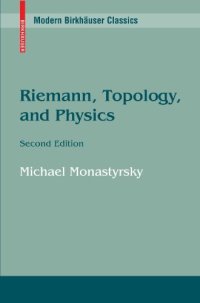
Ebook: Riemann, Topology, and Physics
Author: Michael Monastyrsky (eds.)
- Genre: Mathematics // Geometry and Topology
- Tags: Applications of Mathematics, Mathematical Methods in Physics, Topology, History of Mathematical Sciences
- Series: Modern Birkhäuser Classics
- Year: 1999
- Publisher: Birkhäuser Basel
- Edition: 2
- Language: English
- pdf
This significantly expanded second edition of Riemann, Topology, and Physics combines a fascinating account of the life and work of Bernhard Riemann with a lucid discussion of current interaction between topology and physics. The author, a distinguished mathematical physicist, takes into account his own research at the Riemann archives of Göttingen University and developments over the last decade that connect Riemann with numerous significant ideas and methods reflected throughout contemporary mathematics and physics.
Special attention is paid in part one to results on the Riemann–Hilbert problem and, in part two, to discoveries in field theory and condensed matter such as the quantum Hall effect, quasicrystals, membranes with nontrivial topology, "fake" differential structures on 4-dimensional Euclidean space, new invariants of knots and more. In his relatively short lifetime, this great mathematician made outstanding contributions to nearly all branches of mathematics; today Riemann’s name appears prominently throughout the literature.
"The book is highly recommendable—for students and scientific workers—not only for the valuable information in it, but also for its spirit: history and higher mathematics are not dry here; they become alive and motivate further studies."—ZAA
"This is a new translation of a book first published in English in 1987... Translated from Russian...it consists of two separate but related works. The first is an account of the life and work of Riemann, the second an account of several different topics in physics which are illuminated by the introduction of topological ideas. The discussion of Riemann is even better in the new edition. The mathematical account is richer and various errors have been corrected... The second half has been revised in a similar fashion... It has also been enriched by a new chapter which starts with von Neumann algebras and the work of Vaughn Jones... The book does three things very well: it reminds us of the range and depth of Riemann’s interests, which are emblematic of what the author values in mathematical physics; describes some of the many successes of Russian mathematicians and physicists; and it provides a lucid account of some modern work in which topology is genuinely applied. Books like this are vital for the health of mathematics and it is to be hoped that more will be written."---Mathematical Reviews
This book is worth reading for its second (stand-alone) half, about topology and physics. Michael Monastyrsky (MM) relies mainly on words to convey the big picture of many connections between the two topics. I had a number of "aha" moments while reading it, which had eluded me despite having struggled through some more formal introductions to T&P. Chapter 9's discussion of the relationship between homology and homotopy and later chapters about liquid crystals and topological particles were especially enlightening. That said, I think it would be difficult to have those moments if you hadn't already had at least an introduction to algebraic topology (e.g., Michael Henle's wonderfully clear "A Combinatorial Introduction to Topology," from Dover). The treatment gets more abstruse in the later chapters, where it feels like MM was rushing. E.g., the chapter on braids and knots, which should be relatively intuitive to understand, struck me as quite abstract even though I'd already read a couple of books on the subject. And the discussions of magnetohydrodynamics and "What's next?" (at the end) were more like catalogues of topics than anything you could learn from. MM is also sometimes quite rambling, such as in his long chapter on gauge fields, in more than 80% of which he doesn't discuss topology at all. The rambling tendency is even more evident in the Riemann part of the book. E.g. Dirichlet doesn't make an appearance in the chapter entitled "Riemann and Dirichlet" until, again, 80% of the way through the chapter; and in the 2-page chapter "Last Years", MM jumps from Riemann's marriage and illness in 1862 to June 28, 1866, then to early 1866, then to June 14 and finally to Riemann's death on July 20 (@75-76). Even though Riemann's accomplishments are extremely interesting, there's something flat and dull about the writing style in this part of the book, so much so that I'd lost interest on two previous attempts to read it. But the main flaw in this section is that MM seems unsure of what level of readership he's aiming for. E.g., on one hand MM feels readers need to be told that "shock waves are formed when high-speed aircraft break the sound barrier, when atomic bombs explode, and so forth" (@69), but on the other hand if you don't have any prior background in complex analysis you will be lost. (It also doesn't hurt to have encountered monodromy mappings previously (@56)). A few more diagrams would have been helpful especially in the Riemann section, and throughout the book it would have been nice if the diagrams had been re-drawn from the Russian edition: some of them are quite murky, and one or two of them don't seem to match the revised text. All in all, I give "Riemann" barely a 3, and "T&P" a 4, for an average of 3.5 stars.